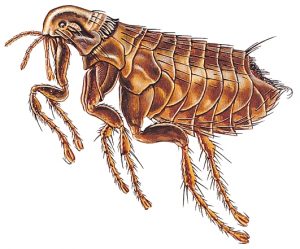Flea control

The flea is a true parasite by nature, because it literally lives off the blood of its “host”. It cannot survive or reproduce without this relationship. The dog flea can also suck human blood, and vice versa, which means that the flea’s diet includes all kinds of hot-blooded creatures.
Nest locations:Fleas live on the bodies and fur of “hosts”, which can be domestic animals and in some cases humans. Female fleas lay a large number of eggs every day, which fall off the “host”. They hatch into larvae that hide on carpets and upholstery. Adult fleas can already sense warmth and movement and will simply jump at a passing “host” to live on.
Life cycle: The development of a flea from egg to adult takes 16-50 days, but can be extended up to 1.5 years under unsuitable conditions. The lifespan is 3.5 months to 1 year. They lay 100-400 eggs. after the eggs open, the larva hatches in a week.
Damage caused: Fleas cause severe skin irritation and allergic dermatitis in both animals and humans, and transmit the mites of pseudotuberculosis, listeriosis, tuberculosis, typhoid fever, plague and typhoid fever.
Frequency of control: it is recommended to control fleas in the basements of cooperatives every year in June or July.
Conditions for control: finding fleas in basement rooms means an unsatisfactory sanitary situation. Certainly rats and (or) stray cats. This option also requires rat control in basements, but before that, the cats living in the basement need to find a new habitat. Also, clean out basement flooding and close windows and other openings to prevent cats from getting back in.
Mistakes that are made? Cats in the basement, lots of stuff in the basement.
What tools do we use and how quickly do they work? Rapid means are used to kill fleas. With a concrete floor and a bare basement, the result is generally quick and good. If there are a lot of basement crawlspaces and cobblestones, or if there is a sand or rubble floor, it can be very difficult to eradicate fleas completely.
